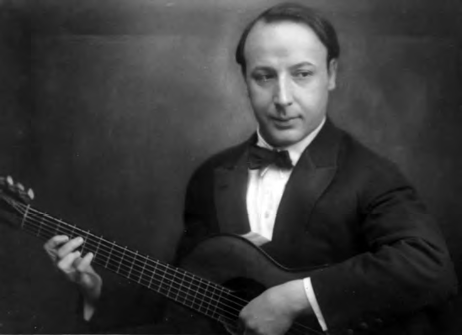Precursive Methods: A Modern Method for the Guitar. School of Tárrega by Pascual Roch and Escuela razonada de la Guitarra by Emilio Pujol
After Isaac Nicola returned from his European studies with Emilio Pujol, he was inspired by this experience and what he learned from the spirit of Tárrega’s school. During the creation of his method, Nicola started to review and study the methods available to enrich his background. Francisco Tárrega’s legend inspired Pujol and Roch’s methods; thus, their works constitute direct precursive works of Nicola’s creation.
One of the disciples that first started to decode the teachings of Francisco Tárrega was Pascual Roch (Valencia, Spain 1864- Havana, Cuba 1921), who settled in Cuba in 1911. He wrote A Modern Method for the Guitar. School of Tárrega published in 1921. The method has been published in English, French, and Spanish by G. Schirmer Inc. from New York, being one of the more widespread texts for the classical guitar of the epoch.[1]
Roch divided it into three volumes. Volume one contains the first two parts devoted to technical training, some accessible Recreations, and a few Preludes and Studies. Volume second has parts three and four of the mechanical portion, with more Preludes and compositions. Volume third includes the last part of the mechanical training, Preludes, and several of Tárrega’s pieces, with other works transcribed by the author.[2]

Figure 6 Pascual Roch (Valencia, Spain 1864- Havana, Cuba 1921)
This work has an extensive selection of exercises, scales, arrangements, preludes, and studies. It is worth noting the repertoire of Western composers including Schumann, Grieg, and Mozart. The studies, preludes, and compositions were received directly from Tárrega while Pascual Roch was under his instruction. Roch added some of his own pieces to the method such as Valse, Scottische, and Habanera.
In summary, Pascual Roch’s books work on all technical aspects necessary for classical guitar performance. His method is relevant because it portrays vital elements of Tárrega’s school, both technical and musical.
Another precursive method of Nicola’s work was Escuela razonada de la Guitarra by Emilio Pujol, published in 1934. Pujol, Nicola’s mentor and role model, also based his work on the teachings of Francisco Tárrega. His method is one of the field’s most accomplished and comprehensive works. It constitutes a referential output with four volumes, including the instrument’s history and the technique necessary to play it successfully, among other subjects of interest.
The first book (1934) includes a general theoretical exposition. The second (1940) and third books (1954) are practical and progressive studies on different technical difficulties. The last book (1971) expands on the content presented in the previous books. Pujol envisioned a fifth book but never got to edit or publish it.
In the first book’s Introduction, Pujol recommends accompanying the study of the instrument with general musical studies like solfege, harmony, analysis of musical composition and its forms, history of music, and attendance to concerts. Nicola, shared and defended this viewpoint, implementing this type of curriculum in Cuba.
Later, in the Introduction, Pujol talks about the weight of practicing correctly in student development. He emphasizes the need to focus on quality rather than quantity. The most crucial thing in the study is the intensity of attention, listening to our playing carefully, and constantly examining our playing so we can act on it and improve. Like Nicola would do later in his method, Pujol refers to the professors as the primary source of guidance, leading the pupils in the necessary steps.

Figure 7 Emilio Pujol Vilarrubi (1886-1980)
Emilio Pujol’s repertoire selection and extensive body of works in the method influenced Nicola’s pedagogical and musical point of view. Pujol’s thoughts on practice and musicianship in general were taken to heart by Nicola who incorporated them into his own teaching and transmitted them to his students for generations.
[1] Pedreira, Historia de La Guitarra. Selección de Lecturas, 177.
[2] Pascual Roch, A Modern Method for the Guitar (School of Tarrega), vol. 1 (NY: G. Schirmer, Inc., 1917), 8.
[3] Pedreira, Historia de La Guitarra. Selección de Lecturas, 107.
[4] Emilio Pujol, Guitar School: Theoretical-Practical Method for the Guitar: Based on the Principles of Francisco Tárrega, vol. 1(Boston: Editions Orphée, 1983), 60.